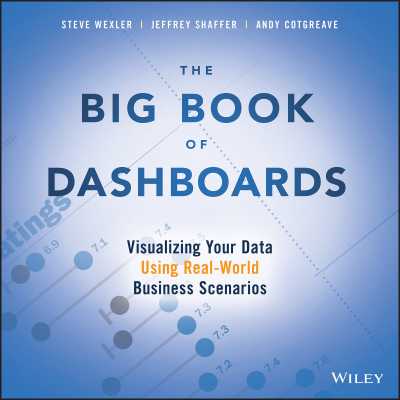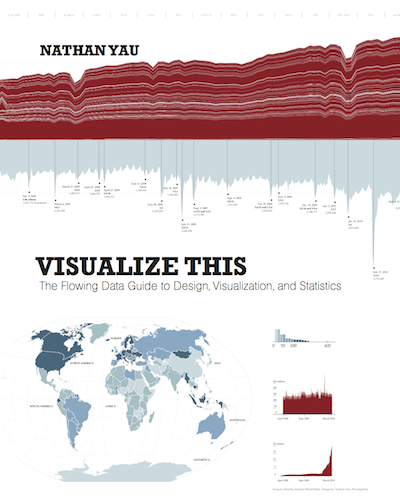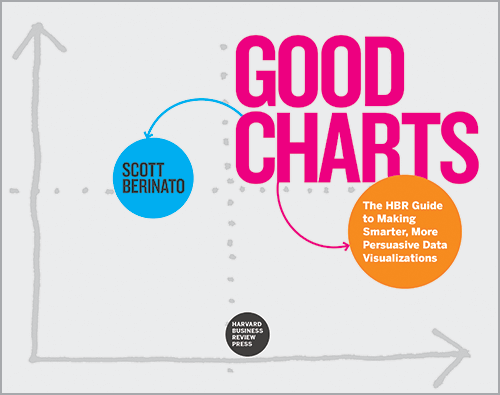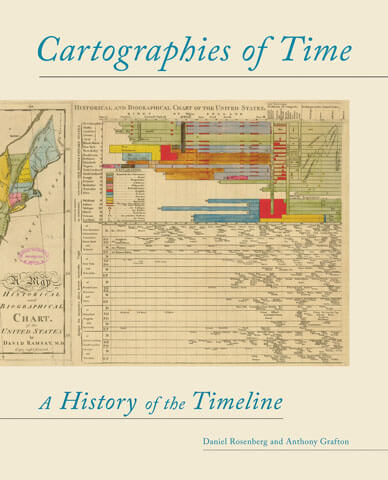
“Most of us need to listen to the music to understand how beautiful it is. But often that’s how we present statistics: we just show the notes, we don’t play the music.” – Hans Rosling, Swedish statistician
datapine is filling your bookshelf thick and fast. Previously, we discussed the top 19 big data books you need to read, followed by our rundown of the world’s top business intelligence books as well as our list of the best SQL books for beginners and intermediates. Now that you’re sold on the power of data analytics in addition to data-driven BI, it’s time to take your journey a step further by exploring how to effectively communicate vital metrics and insights in a concise, inspiring, and accessible format through the power of visualization.
Data visualization, or ‘data viz’ as it’s commonly known, is the graphic presentation of data. These aesthetically striking portrayals are the most effective way to succinctly translate large segments of complex data to a wide audience. Successful visualizations are aesthetically beautiful, providing layers of detail that generate deeper dimensions of insight and whole new layers of understanding. They can be fun and interactive, too.
The field of online data visualization is growing, and whether you’re a data viz expert or just getting started, there is a wide range of books that will help you learn new skills and remain ahead of the pack.
Not sure where to start? A mere Amazon search of this topic returns over 15k items. That’s a colossal number of books on visualization. And while some of them we consider the best books on data visualization, some are really not.
But don’t fret, because we’ve conducted the research and reading on your behalf, refining our findings to create our list of the world’s best 20 data visualization books.
This list is in no particular order, but what we promise you is that these are 20 of the best books on data visualization available today, and you’ll find there’s something for everybody.
Here we’ve included prose based on visualization history, theory, psychology, and practical implementation as well as intricate graphical presentation tips and a visually stunning coffee table book for inspiration.
But before we delve into our list of books on data visualization, here are some facts and figures for your inspiration.
Data visualization: What You Need To Know
- 90% of the information transmitted to the brain is visual – a testament to the power and potential of data visualization.
- People are 30 times more likely to absorb high-quality infographics than plain text.
- Studies suggest that if a scientific claim is presented in only words or numbers, 68% of people will deem the information to be accurate and truthful. But if the same insights or metrics are presented in a simple graph, the number rises to 97%.
- A BI strategy that leverages data visualization will provide an ROI of $13.01 back on every dollar spent.
Now that we’ve established the importance and potency of visualization in the digital age, let’s take a look at our rundown of the best data visualization books.
1) “The Visual Display of Quantitative Information” by Edward R. Tufte
**click for book source**
You can’t make a list of data visualization books without including Edward Tufte. Tufte is considered to be amongst the foremost pioneers in the field and this really is considered the best book on data visualization out there. “The Visual Display of Quantitative Information” is one of his most famous data visualization books. It covers the theory and design of data graphics and provides 250 illustrations of the best and worst examples. Though printed in 1983, it remains a classic and a bestseller on Amazon. Tufte provides an astute introduction to core visualization theories, building on these concepts throughout the book, and frankly, this should be on every data viz bookshelf.
2) “Storytelling With Data: A Data Visualization Guide for Business Professionals” by Cole Nussbaumer Knaflic
**click for book source**
Laszlo Bock, former SVP of People Operations at Google, introduces one of the most beautiful data visualization books in our lineup in a way that nobody else can:
“In ‘Storytelling With Data,’ Cole has created an of-the-moment complement to the work of data visualization pioneers like Edward Tufte. She’s worked at and with some of the most data-driven organizations on the planet as well as some of the most mission-driven, data-free institutions. In both cases, she’s helped sharpen their messages and their thinking.”
You may be able to create complicated, technical, and colorful visualizations and load them with a ton of data. But, if your target audience can’t decipher them, what’s the point? In the end, visualizations are meant to convey or highlight what’s happening with your data – they’re supposed to tell a story. That is why “Storytelling With Data” is on our list.
Cole Knaflic’s mission is to teach readers. “Don’t simply show your data – tell a story with it,” and her offering, which we consider to be one of the world’s best data visualization books, demonstrates how to go beyond conventional tools to reach the root of your data while using a dashboard storytelling process to create an engaging and informative presentation in a way that is accessible to everyone.
The author recently published an “expanded follow-up” to her book called “Storytelling With Data: Let’s Practice!”. In this guide-style publication, Cole Knaflic presents exercises and real-world examples to put all the knowledge you gain from the first piece into practice.
3) “The Big Book Of Dashboards: Visualizing Your Data Using Real-World Business Scenarios” by Steve Waxler, Jeffrey Shaffer, and Andy Cotgreave
**click for book source**
Our next best book to learn data visualization is the “The Big Book Of Dashboards”. Written by professionals in the field, it provides readers with the perfect mix of the theoretical part of using data visualizations and the practical part of actually applying this knowledge to real-life scenarios.
With dozens of real-world dashboard examples coming from various formats such as print, desktop, or mobile, and different industries such as finance, healthcare, human resources, sports, marketing, and more, this ultimate handbook on business dashboards will give you all the necessary tools and knowledge to build an effective dashboard using data visualizations. In addition to the examples, the book also offers insights into the psychological factors that go into building an engaging and efficient dashboard.
With more than 30 years of experience combined, these authors put into words the best practices you should follow as well as the challenges you would most likely encounter during your dashboard design process and give you the necessary tools to deal with all of them. It is a definitive reference for anyone who wants to master the art of dashboarding.
4) “Data Sketches: A Journey Of Imagination, Exploration, And Beautiful Data Visualizations” by Nadieh Bremer and Shirley Wu
**click for book source**
This next piece is not a typical data visualization book that shows you the theoretical aspect of using visuals to understand data. Data Sketches is a publication that documents the creative process of authors Nadie Bremer and Shirley Wu in creating 24 data visualization projects. These projects explore different topics which include the Olympics, the Royals, myths, presidents, and more, exploring different technologies, visualization, and design techniques to show that data viz is an equal part of science and art.
In addition to providing a behind-the-scenes look into the author’s processes through sketches and notes, it also offers detailed insights on core data visualization concepts, data gathering and sketching techniques for the web, as well as practical lessons based on the challenges they faced during the creation of these 24 projects.
Data Sketches is a book covered in full-color images that will lead you through the complete process of creating a data visualization project. You will also find the finalized version of the 24 projects and learn how powerful data storytelling can be.
Since its publication in 2021, it has been praised by various professionals in the industry. Here is an excerpt from Andy Kirk, another data viz author that you will find later on this list:
“This book brings the perfect blend of ingredients together for a nourishing recipe of inspiration and knowledge beneficial to beginners and experienced practitioners alike. Nadieh and Shirley are generational talents. Through their data visualization work, they relentlessly exhibit a wide spectrum of capabilities across the creative, editorial, analytical, and technical dimensions”.
5) “Data Visualization – A Practical Introduction” by Kieran Healy
**click for book source**
If you’re searching for a book that combines theory and practice in a comprehensive and hands-on approach to visualization, you need to have this one on your bookshelf. Written by a professor of sociology at Duke University, this book provides researchers and students instructions on using R and ggplot2 in an innovative and coherent manner.
Whether you are a beginner or an advanced user of data, statistics, and visualizations, this fun, and readable book, authored by Kieran Healy, will show you the unique world of visualizations that can be effectively used for communicating data in a graphical way.
6) “How Charts Lie: Getting Smarter About Visual Information” by Alberto Cairo
**click for book source**
While displaying data in beautiful charts, graphs, and diagrams is the most successful way to uncover hidden trends and patterns in our data, it doesn’t come without challenges. When not used correctly, charts can lie. The information in them can be misleading or misunderstood in a number of ways, a tactic that has been used for decades by journalists, politicians, and advertisers to manipulate audiences.
Under that premise, renowned journalist and data visualization expert, Alberto Cairo builds his latest publication: “How Chats Lie: Getting Smarter About Visual Information”. In this book, Cairo uses a wide range of examples to teach readers how to understand graphs and charts and how to spot the misleading visualizations we often see in the media. It is a perfect guide for beginners that need to understand how charts work and the bad practices that need to be avoided when presenting data in a visual way.
7) “Infographics Designers’ Sketchbooks” by Steven Heller and Rick Landers
**click for book source**
Focusing less on data analytics and more on eye-grabbing presentations, “Infographics Designers’ Sketchbooks” is a data visualization book that will inspire your creative efforts from start to finish.
What’s particularly impressive about this data visualization design book is the fact that it offers a rare glimpse into the minds of 50 of the world’s most prolific graphic designers through their personal sketchbooks. By examining the creative process of the planet’s best visualists, you’ll be able to spot the link between data and drawings. As a result, you’ll gain the tools and inspiration you need to create a wealth of stunning infographics that will help you present critical information that enlightens and creates value rather than excluding and causing confusion.
8) “Knowledge is Beautiful” by David McCandless
**click for book source**
Boasting near flawless reader reviews on Amazon, this graphically-driven book on data visualization makes an excellent companion when it comes to thriving in the digital age.
“Knowledge is Beautiful” is celebrated data journalist David McCandless‘ best-selling publication on the subject, and its concept is simple: using sensational visuals to reveal surprising insights into how the world really works and using this knowledge for your own innovations.
If you’re looking to transform head-turning, jaw-dropping aesthetic concepts that connect with others on a meaningful level while yielding real results, this is one of the best data visualization books you will ever own.
9) “The Book of Circles: Visualizing Spheres of Knowledge” by Manuel Lima
**click for book source**
The follow-up to the critically-acclaimed “The Book of Trees and Visual Complexity”, this offbeat and wildly valuable book on data visualization delves deep into millennia of circular information innovation and design.
Coupling a kaleidoscopic array of inspirational visual designs throughout the ages with stunning modern-day examples of visualization in action, author Manuel Lima connects the enduring concept of the human relationship with visuals and its application to data in a way that is exciting, engaging, and practical in equal measure. One of the visualizing data best books available today.
10) “Effective Data Visualization: The Right Chart for the Right Data” by Stephanie Evergreen
**click for book source**
Excel has been the primary tool to generate visuals and manage data for decades. That said, it is still intimidating software that makes the lives of a lot of users very difficult. With that issue in mind, author Stephanie Evergreen put together “Effective Data Visualization: The Right Chart for the Right Data” as a guide for readers that want to learn how to create Excel charts and graphs in an efficient way.
Using approachable and funny language, Evergreen guides readers into learning the fundamentals of data visualization in Excel. The book includes the types of graphs available and on which scenario they are most appropriate to use, as well as a step-to-step checklist to create them on the tool. Originally published in 2016, it has a second edition that was published in 2019 that includes a rewritten chapter on qualitative data as well as 9 new chart types and shortcuts on Excel. A must-read for anyone looking to become an Excel guru.
11) “Better Data Visualizations: A Guide for Scholars, Researchers, and Wonks” by Jonathan Schwabish
**click for book source**
As you’ve probably noticed already with our list of books, visuals make the world better. Every piece of information is better received and perceived when it comes in a visual format. Author Jonathan Schwabis put the value of visuals into perspective with his piece “Better Data Visualizations: A Guide For Scholars, Researchers, And Wonks”.
Through more than 500 examples, the author aims to teach its readers the value of data visualizations and how to create effective ones in different contexts. Anyone reading this piece can expect to learn the do’s and don’ts of visual design, the core visualization types and how each of them should be used, and how to clearly communicate your message using graphics.
If you don’t trust our word for it, maybe this excerpt from a reader’s review will convince you: “This book is quite extraordinary in regards to giving the presentational theory of graphed information. Truly a must to anyone who wants to tell stories through data”.
12) “Data Visualisation: A Handbook for Data Driven Design” by Andy Kirk
**click for book source**
Voted one of the “six best books for data geeks” by The Financial Times, “Data Visualization: A Handbook for Data Driven Design,” authored by Andy Kirk, offers a clear, concise, and digestible introduction to the field.
With a host of hand-picked data visualization examples as well as a wealth of real-world tips, methods, approaches, and insights, this really is one of the best books on data visualization for those getting started.
The language is accessible, the advice is practical, and in addition to a physical copy of the book, you will also gain access to comprehensive online data analysis tools and support, which includes a selection of exercises so you can practice your skills. Be aware that there is a second edition to this book published in 2019.
13) “Fundamentals of Data Visualization: A Primer on Making Informative and Compelling Figures” by Claus O. Wilke
**click for book source**
Being successful when it comes to data visualization is not an easy task. There is a wide range of tools and techniques out there which can make you feel confused and overwhelmed. If this is the case for you, don’t worry, author Claus Wilke data visualization book has you covered.
In “Fundamentals Of Data Visualization: A Primer On Making Informative And Compelling Figures”, Wilke guides readers through a practical journey to understanding the fundamentals of successful visuals. Covering topics such as the basics of colors, details on chart types, examples of poorly constructed visuals, and tips on how to turn large datasets into a compelling story, this publication is the perfect overview for scientists, engineers, and anyone whose work involves generating data visualizations. No matter the visual analytics tools or programming language you use, after reading this book you should be able to extract the maximum potential out of your visual design process.
14) “Visualize This: The Flowing Data Guide to Design, Visualization, and Statistics” by Nathan Yau
**click for book source**
One of the most valuable visualizing data books of recent times, data viz guru Nathan Yau provides another great practical handbook on visualization and how to approach real-world data in his masterpiece, “Visualize This.” We recommend this book in color to take full advantage of the step-by-step tutorials on how to visualize and tell stories with data.
For developers, there are code examples in R, Python, and JavaScript. Yau’s website flowingdata.com is another great source for all levels of visualization that also showcases fun data viz experiments.
15) “Good Charts: The HBR Guide to Making Smarter, More Persuasive Data Visualizations” by Scott Berinato
**click for book source**
Published in May 2016, this is one of the most relevant visualizing data books on the market. What we like about “Good Charts” is that it’s accessible for the data viz beginner but just as helpful for the more advanced dashboard design user.
Berinato highlights the important point that data viz is no longer being left just to the specialists: data scientists and professional designers. A new generation of data visualization tools, like datapine, and massive amounts of data make it easy for the layperson to create visualizations that communicate ideas far more effectively than spreadsheets and PowerPoint charts. In “Good Charts,” Berinato provides an invaluable guide to how visualization works and how to use data viz to influence and persuade. This is a must-read.
Another gem coming from this author is his second title and the most recent book: Good Charts Workbook: Tips, Tools, and Exercises for Making Better Data Visualizations. The beauty of this publication lies within the practical part; a hands-on guide that will enable you to create your own visualization while teaching you how to develop your own visualization and thinking processes. A must-read for anyone interested in the practical part of data visualization.
16) “Information Dashboard Design: Displaying Data for At-a-glance Monitoring” by Stephen Few
**click for book source**
Don’t let the lackluster cover fool you, or as they say: don’t judge a book by its cover, because this visualizing data book has plenty to offer in the way of visualization. Few guides are so helpful in providing a wide range of good and bad dashboard examples. Moreover, author Stephen Few offers a great introduction to the principles of data visualization and design theory. If you wonder which graph displays data in top-to-bottom fashion, then this piece is for you. Oh, and if you become a Stephen Few fan, he has multiple visualization and analytics books to check out.
17) “Information Graphics” by Sandra Rendgen, Julius Wiedemann
**click for book source**
Looking for inspiration? Or just love data viz as an art? One of the most beautiful data visualization books is a great coffee table book or one to keep next to your desk for when you’re in a data viz rut.
It has a little of everything, providing over 400 examples of information graphics from around the world, covering journalism art, government, education, business, and more. The introductory essays on data visualization history and theory as well as data journalism are also a good read, and the accompanying images are worth a long look.
18) “Cartographies of Time: A History of the Timeline” by Daniel Rosenberg
**click for book source**
This book won’t help you get your business intelligence dashboard up and running for next week’s board meeting, but history buffs will be enthralled by the comprehensive history of graphic representations of time in Europe and the United States from 1450 to the present. The accompanying graphics prove that visualization isn’t just a modern-day science. We have been striving to draw time long before the conception of dashboards!
19) “Semiology of Graphics: Diagrams, Networks, Maps” by Jacques Bertin
**click for book source**
We round out this list with another visualization pioneer, Jacques Bertin. Originally published in 1967 in French, Bertin’s Semiology of Graphics holds a significant place in the theory of information design.
Founded on Jacques Bertin’s practical experience as a cartographer, Part One attempts to synthesize principles of graphic communication with the logic of standard rules applied to writing and topography. Part Two brings Bertin’s theory to life, presenting a close study of graphic techniques, including shape, orientation, color, texture, volume, and size in an array of more than 1,000 maps and diagrams.
20) “Beautiful Visualization, Looking at Data Through the Eyes of Experts” by Julie Steele, Noah Iliinsky
**click for book source**
This piece is part of O’Reilly’s “Beautiful” series, with each book a collection of essays from people who work in the field. “Beautiful Visualization,” authored by Julie Steele and Noah Iliinsky, describes the design and development of some well-known visualizations by examining the methods of 24 visualization experts.
One of the great things about this big data visualization book is that the authors approach their projects from a variety of perspectives: artists, designers, commentators, scientists, analysts, statisticians, and more. The topics include:
- The importance of storytelling through a simple visualization exercise.
- Color and how it conveys information that our brains recognize before we are cognizant of it.
- Uncovering a method to the madness of air travel with a civilian air traffic visualization that is beautifully portrayed.
To summarize, here is our list of the best books on data visualization:
- “The Visual Display of Quantitative Information” by Edward R. Tufte
- “Storytelling With Data: A Data Visualization Guide for Business Professionals” by Cole Nussbaumer Knaflic
- “The Big Book of Dashboards: Visualizing Your Data Using Real-World Business Scenarios” by Steve Wexler, Jeffrey Shaffer, Andy Cotgreave
- “Data Sketches: Journey Of Imagination, Exploration, And Beautiful Visualizations” by Nadieh Bremer, Shirley Wu
- “Data Visualization – A Practical Introduction” by Kieran Healy
- “How Charts Lie: Getting Smarter About Visual Information” by Alberto Cairo
- “Infographics Designers’ Sketchbooks” by Steven Heller and Rick Landers
- “Knowledge is Beautiful” by David McCandless
- “The Book of Circles: Visualizing Spheres of Knowledge” by Manuel Lima
- “Effective Data Visualization: The Right Chart For The Right Data” by Stephanie Evergreen
- “Better Data Visualizations: A Guide for Scholars, Researchers, and Wonks” by Jonathan Schwabish
- “Data Visualisation: A Handbook for Data Driven Design” by Andy Kirk
- “Fundamentals of Data Visualization: A Primer on Making Informative and Compelling Figures” by Claus O. Wilke
- “Visualize This: The Flowing Data Guide to Design, Visualization, and Statistics” by Nathan Yau
- “Good Charts: The HBR Guide to Making Smarter, More Persuasive Data Visualizations” by Scott Berinato
- “Information Dashboard Design: Displaying Data for At-a-glance Monitoring” by Stephen Few
- “Information Graphics” by Sandra Rendgen, Julius Wiedemann
- “Cartographies of Time: A History of the Timeline” by Daniel Rosenberg
- “Semiology of Graphics: Diagrams, Networks, Maps” by Jacques Bertin
- “Beautiful Visualization, Looking at Data Through the Eyes of Experts” by Julie Steele, Noah Iliinsky
Now, it’s time to step away from those Excel spreadsheets, forget those static tables, and start telling a real story with your data. As you may have gathered, data visualization is the best way to squeeze every last drop of value from the metrics and insights that are available at your fingertips, and now that you’ve got the tools you need for success, it’s time to get going.
Do you want to get a head start on deciding what data visualizations you should start to build while waiting for your books to arrive? Check out our 14-day trial, completely free!
Source link





















